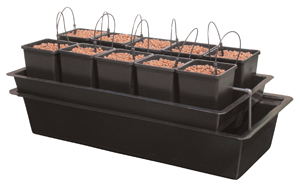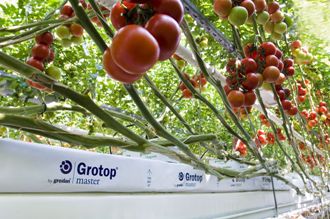Manufacturers
Categories
Information
More Information
Important Links
Drip Irrigation

Drip systems are perhaps the most common type of hydroponics systems in the world, owing to their simplicity. A clock controls a pump in the nutrient tank. When the clock switches on the pump and a small drip mechanism drips a nutrient solution over the base of each plant. The excess nutrient solution is caught in the nutrient reservoir for subsequent reuse, or drained away. In this system, the plants are kept in an inert substrate. Like with the ebb and flood system, the watering frequency is different.
Wilma
The ‘Wilma’ enables you to give your plants the ideal watering preventing water-logging, which is common with hand watering. With use of a segmental timer it allows you to feed the plants little but often drawing in more oxygen. It also has excellent drainage to prevent salt build up which is also common with hand watering and any unused nutrient, simply drains back into the reservoir. No more having to tend to your plants once or twice a day, let the Wilma do the work for you and go and enjoy yourself. All you need to do is keep the nutrient reservoir topped up.
These links will take you to the Nutriculture website:
- Click here to see setting up a Wilma system Step 1
- Click here to see setting up a Wilma system Step 2
- Click here to see setting up a Wilma system Step 3
Tips
Only strong, healthy transplants or cuttings should be placed in the
WILMA system. Pots or plastic wraps (rockwool blocks) should be
removed, but do not wash off any propagation medium. Plant so that
chosen medium for growing just covers propagation block, but without
burying seed leaves or first true leaf.
Inert open draining medium (clay pebbles, rockwool cubes) should be
thoroughly wetted and given time to drain before planting.
Soil-type media (coco, compost) should be damp throughout before
planting.
Running Times
Experience will show the best way to run the WILMA systems, but these
are guidelines for beginners.
It is a good idea to use a 15 minute segmental timer to automate the system.
Young Plants
It is better to run the system for a few short periods than one long watering.
Young plants need less watering than mature plants.
Slight under watering is better than over watering.
1 – 2 periods per day will usually be sufficient for most young plants.
Do not over feed when young. New plants will be ok at approximately
half dose nutrient strength.
Mature Plants
Observation of the plant is needed to decide on the amount of watering.
NO media should be allowed to dry out completely.
The maximum number of floods is 1 ‘on’ period per hour during daylight
hours, though most fully mature plants will not need this many.
Maintenance
There are no daily tasks associated with your WILMA system. Maintain
solution strength and pH according to nutrient label instructions or
growing schedule. The nutrient solution should be completely changed
once a month, or more often depending on relative plant maturity, speed
of growth and environmental conditions.
All the drippers should be checked occasionally to ensure correct flow
rates, and the system should be flushed thoroughly with a weak acid
solution or other cleaning agent between crops and then flushed thoroughly
with water before replanting. Ata-clean can also be added to
nutrient solutions to prevent blockages.
Solution heating should not be necessary except where environmental
conditions dictate, (low night-time temperatures).
When changing solution, plants may benefit from one watering with just
water, to prevent any build up of unused nutrient salts (particularly in
soil-type media).

